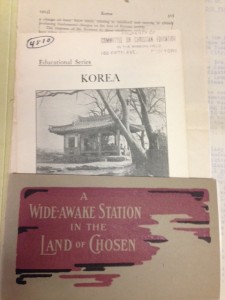I spent yesterday and today getting acquainted with my first archival box. To learn and get experience with writing a finding aid, I’m working with materials that already have a finding aid, “The Chinese Church of Christ in Korea papers 1908-1975.” Some of what needed to be done was basic copy editing and formatting the document.
 But the fun part was getting to explore the folders in the box. Part of what I was doing was comparing the box content to the descriptions in the finding aid, to make sure that it was accurate, and as detailed as it needed to be.
But the fun part was getting to explore the folders in the box. Part of what I was doing was comparing the box content to the descriptions in the finding aid, to make sure that it was accurate, and as detailed as it needed to be.
Exploring documents that ranged from handwritten letters to missionary history to brochures about Korea, I had to remind myself not to read the documents themselves. Processing an archive isn’t about reading the documents. Handing me pages and pages of typewritten and handwritten documents and telling me not to read them takes willpower! I only skimmed. I told myself I was familiarizing myself with the documents, and checking to see if any details jumped out that would improve the level of historical detail in the finding aid, to help researchers (and those searching on the web) find it, with better keywords. Yeah! That’s what I was doing. Not reading! No reading here!
The documents that I absolutely did not read covered the work Chinese missionaries were doing to establish missions and mission schools in Korea, covering a time and place in history I had known absolutely nothing about. And now I’m curious to learn more. (Maybe a stop by the UTS library on the way home!)
After I submitted my work on the finding aid for edits, my next task was to work my way through a box of floppy disks, get the documents onto the hard drive so they could be processed. Some of the disks I handled had one or two files on them, mostly Word documents, sometimes a PowerPoint or PDF. It is a little bit mind boggling to think about the fact that only a few decades ago, our portable media could hold mere kilobytes or megabytes of data. And now, several gigabytes can fit on an even smaller device.
 Today, I worked with, and handled documents that were typed or handwritten in the early 20th century. And floppy disks with documents saved in the early 2000’s.
Today, I worked with, and handled documents that were typed or handwritten in the early 20th century. And floppy disks with documents saved in the early 2000’s.
I’d call that a very good day!